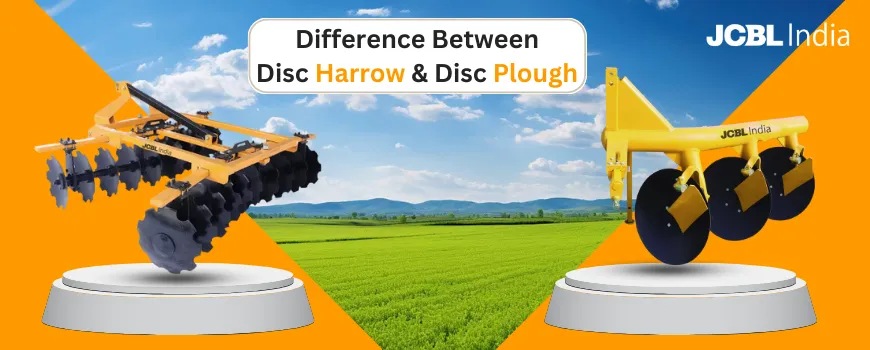A successful harvest depends on using the right farming equipment. The crop could only produce the desired results if the soil is properly prepared to the appropriate depth.
To assist farmers in choosing the best agricultural equipment, JCBL Agri is guiding this blog by explaining the difference between a disc plough and a disc harrow. Farmers can select the ideal equipment for their particular jobs by being aware of these distinctions.
Both the plough and harrow play important roles in soil cultivation, yet they vary significantly in terms of design, functionality, and the specific tasks they perform. While a plough enables deep soil cultivation, a harrow is adept at refining and levelling the soil surface for lighter soil preparation.
Also Read: Types of Tillage Implements in Agriculture!
Disc Ploughs vs. Harrows
1. Penetration and Strength
A significant difference was found in their penetration and strength when comparing a disc plough with a harrow.
Disc Plough:
The disc plough stands out as a strong farming tool used to break up and upend the soil. Equipped with large rotating disc blades, it cuts through the soil, flipping it over with ease. The plough’s substantial weight and the force exerted by the spinning discs enable it to delve deep into the soil.
Harrow:
The main function of Harrows is not to dig particularly deep, and they are not extremely heavy. Rather, they work best on jobs that take place near the soil’s surface, including seedbed preparation.
It also helps in soil levelling, breaking up clumps, and eliminating small weeds or residual plants. Harrows are typically used by farmers after plowing.
2. Types Of Soil
Disc Plough:
Ploughs are frequently used In heavier soils, such as clay, where extensive digging is necessary to break down compacted layers. However, ploughing sandy soils can result in the depletion of organic matter and soil erosion.
Harrow:
Harrowing works well on different types of soil, such as sandy, clay, and loam. It is especially useful on lighter soils where deep digging could lead to erosion.
3. Components
Disc Plough:
Key components of a disc plough include:
- Hitch Bolt: Essential for connecting the plough to the towing vehicle or implement.
- Lift Crank: Allows for adjustment of the blade depth based on soil type.
- Rear Furrow Wheel: Maintains depth and stability while preventing excessive penetration and tipping over.
- Disc Scraper: Cleans discs to ensure optimal performance.
- Disc Hub: Facilitates blade rotation and functionality during soil cultivation.
Harrow:
Components of a disc harrow include:
- Frame: Provides structural support and stability.
- Discs: Circular cutting blades crucial for soil tillage.
- Spiked Disc: Effective in weed removal and pre or post-seeding cleanup tasks.
- Prickle Chain: Ideal for levelling soil and herbicide application.
- Plain Edge Disc: Offers effective stubble management and weed control.
- Arbour Bolt: Foundation for mounting discs.
- Bearings: Facilitate gang rotation and thrust regulation.
- Scraper: Ensures discs remain free from soil blockages.
- Spool: Maintains disc position and prevents lateral movement.
- Bumper: Prevents discs from colliding, ensuring smooth operation.
Final Thoughts
Choosing between a disc plough and a harrow depends on the specific farmer’s needs and preferences.
Some may prefer the aggressive soil penetration of a plough, while others prioritise the surface-smoothing capabilities of harrows. Considerations such as soil condition, residue management goals, equipment availability, and farming methods play crucial roles in decision-making.
By weighing these factors, farmers can make informed choices aligned with their requirements.

